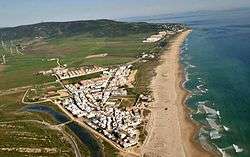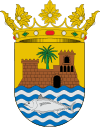Zahara de los Atunes
| Zahara de los Atunes | ||
|---|---|---|
| Village | ||
|
Zahara de los Atunes | ||
| ||
 Zahara de los Atunes Location in Spain | ||
| Coordinates: ES 36°08′07″N 5°50′44″W / 36.13528°N 5.84556°WCoordinates: ES 36°08′07″N 5°50′44″W / 36.13528°N 5.84556°W | ||
| Country |
| |
| Autonomous community | Andalusia | |
| Province | Province of Cádiz | |
| Comarca | La Janda | |
| municipality | Barbate | |
| Elevation | 12 m (39 ft) | |
| Population (2012) | ||
| • Total | 1,200 | |
| Patrons:saint Joseph, Our Lady of Mount Carmel | ||
| Demonym(s) | Zahareños/ Zahareñas | |
| Time zone | CET (UTC+1) | |
| • Summer (DST) | CEST (UTC+2) | |
| Postal code | 11393 | |
| Dialing code | (+34) 956 43/45 | |
Zahara de los Atunes is a village on the Costa de la Luz of Spain in the province of Cádiz and the autonomous region of Andalusia. It is noted for its excellent beaches, an outdoor cinema, and la Iglesia Del Carmen church where, curiously, tuna (caught in Almadraba traps) was butchered and salted. Also in the town there are excellent facilities including a variety of restaurants, cafes and hotels.

It is located 73 kilometers south of the provincial capital, Cadiz or 177 miles of Seville and 40 miles west of Gibraltar. The village is bordered to the south by the municipality of Tarifa and to the north by Barbate.
Etymology
Arnald Steiger, author of a Spanish work entitled "Contribution to the phonetics of Spanish-Arabic and Arabic expressions in the Iberian Romanesque and Sicilian language"[1] says that the name comes from the Arabic which is also documented in ancient Portuguese sáfaro, meaning rough, barren or rocky ground, which in old Spanish is çafara.
Wilhelm Giese' documents confirm this etymology and adds that in Andalusian Arabic the meaning is barren desert (as is the ancient Portuguese form derived from it, would tent to confirm). Interestingly, in Alpujarra, in the municipality of Trevélez, the adjective for bush or scrub is 'zahareña and in Granada, one of the roughest routes to Sierra Nevada bears the name 'Zahareña'.
History
The roots of the settlement date back to the time of the Phoenicians, although until the sixteenth century it was simply a fishing village specialized in trapping tuna (as its name suggests) as one of the most important tuna traps of Andalucia were here. Tuna trapping is a traditional art practiced since at least the Roman rule.
The earliest document which the name of Zahara is found is probably the treaty of accommodation between Vejer and Tarifa dated 1444 AD. The settlement was established following the granting of a licence to extract tuna granted to Guzman el Bueno. This privilege still belongs to his descendants, the Dukes of Medina Sidonia, who own the tuna-trap of Zahara.
Following the granting of this licence, in the first half of the fifteenth century, the family built the Castle of Zahara de los Atunes and Palace of Jadraza. The Palace served three functions: as a fortified castle to protect against Barbary pirates, a residential palace during the Tuna Season and a processing plant to deal with the tuna.
In the early sixteenth century, due to good tuna harvests, Zahara began to be permanently populated by merchants, soldiers and tuna fishermen, who cut 'poached' fish in the privacy of the church!
References
| Wikimedia Commons has media related to Zahara de los Atunes. |


